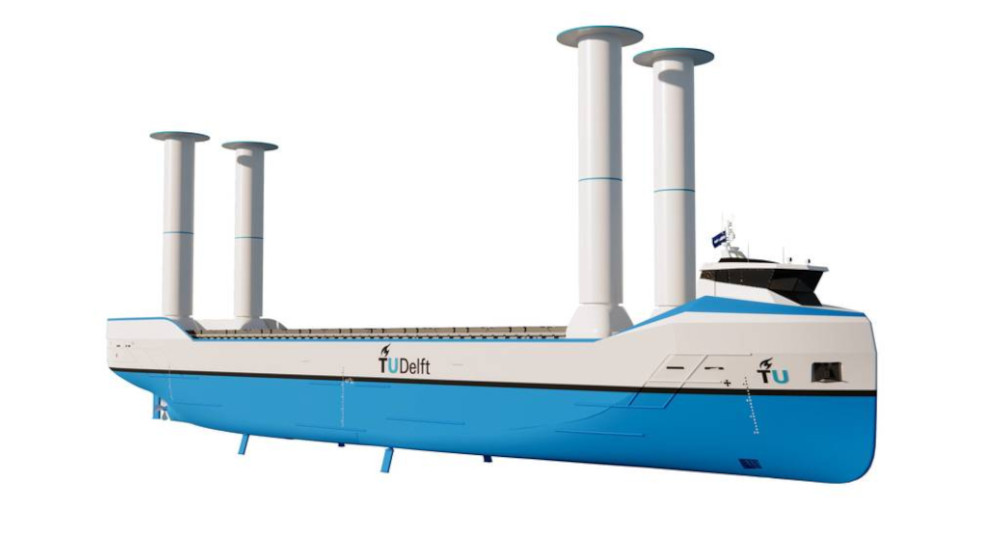Around the world on wind power
Daily newspaper Trouw has discovered wind power: “Commercial shipping is rediscovering the power of sails. With large spinning cylinders, or upright aircraft wings on steel masts. ‘Especially on old cargo ships, modern sails pay themselves quickly back.'”
The International Maritime Organisation (IMO) has therefore set itself the goal of reducing emissions by at least 80 per cent by 2040. Most stakeholders are looking for solutions in alternative fuels, such as bioethanol, to be produced with solar or wind energy.
“But we are never going to meet that goal with that!”, says Albert Rijkens, shipping researcher at TU in Delft. “To produce enough bioethanol or other green fuels for shipping alone, you would already need 60 per cent of all renewable energy in the world today.”
Rijkens therefore prefers to seek a combined solution with one of the oldest alternatives: wind-powered shipping. You used to call that sailing, but today there is a growing list of futuristic alternatives available for that.
Recently, several international parties met in Delft to discuss the state of the art of that modern wind-powered shipping. Now that is still a tiny market of just a tenth of a percent. Because out of an estimated potential of 14,000 cargo ships, hopefully this year we will pass the mark of 100 ships with some form of ‘sail’ on their decks, according to a Lloyd’s Register for Shipping report.
“For the most part, these will be support sails fitted to existing cargo ships as a ‘retrofit’,” says Rijkens. “With current technology, those systems can at best generate 5 to 20 per cent of power. When new, optimised ships are fitted with support sails, the savings can eventually reach as much as 50 per cent of the power required.” […]
“But don’t stare blindly at just the power of such a sail,” says shipping researcher Maurice Jansen of Erasmus University in Rotterdam. “Apart from the power, there are other potential benefits to using wind power.”
Every sailor knows that the best moment after setting sail is shutting down the engine. Jansen: “That also applies on this kind of ship. Even by making partial use of the wind, an engine needs to pound much less on a freighter. That has advantages for stability while sailing and also for the engine itself and the propeller. These wear out less and thus require less maintenance. But the crew also experience wind-assisted sailing as much calmer. So the operational benefits of wind-powered cargo shipping go far beyond energy savings,” Jansen emphasises.
If Jansen has to limit himself to just the business economics picture, the payback time of a wind catcher on an existing ship is now about five years based on the first experiences of shipowners. “Then you also have to factor in cost savings for the rerouting that large ships now often do when there are strong winds on the ocean. For wind-powered cargo ships, it can actually be attractive to catch that wind and thus sail in a much straighter line to the destination.”
Five years sounds like a lightning-fast payback period. So do it straight away, you might say. Yet Jansen warns that the economics of cargo shipping are a bit more complicated than, say, the payback period of solar panels on a private roof. “For now, it will mainly be attractive to put this kind of system on the older, more inefficient ships. The absolute savings will then be large, which will suddenly make ships that sail less economically with such a support sail attractive again to keep in service for a while.”
At TU Delft, Rijkens agrees that this so-called retrofit on existing ships will be an important application of modern support sails for the time being. “But eventually we are moving towards more and more new construction. […]
Independent maritime consultant Eelco Leemans is also cautiously hopeful: “IMO is now mainly talking about tinkering with the efficiency with which we can convert fuel into movement of a ship. But the wind is blowing completely for free. The main issue now is to come up with smart systems to use that free energy.”
Besides reduced emissions of CO2, as well as polluting nitrogen oxides and soot, Leemans foresees further environmental benefits from part-sailing cargo shipping. “Not only the crew on board benefit from the decreasing noise of the pounding engines. The increasing problem of underwater noise may also decrease as more ships start using the wind.”
Underwater noise is a growing problem for various marine animals. Not only whales and other marine mammals are disturbed by the increasing hum of ship engines in all the world’s oceans. Fish can also have trouble finding each other or their prey when their sounds are drowned out by pounding engines.
Leemans certainly does not expect all shipping to eventually return to more or less wind-driven operation. But it will still take off in a big way, he predicts. “The IMO should therefore mainly make agreements with governments to reduce unfair competition with fossil fuels. Currently, there is little or no tax on fuels, and governments also subsidise storage of liquid gas terminals, for example. But what if, for instance, major international ports start charging much less port fees to shipowners who come to load or unload a semi-sailing cargo ship?”
In a number of countries, such as Norway, Finland, France and the UK, the government already supports these innovations, Leemans observes. “The Dutch government, nota bene, also has a Maritime Master Plan. But that only provides support for alternative fuels, not for systems to use wind. So that’s where a traditionally seafaring nation like the Netherlands can still make big strides.”
Source: a longer article by Rob Buiter in Trouw (subscribers only).
Image: TU Delft


